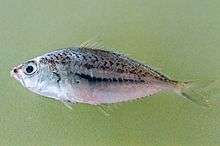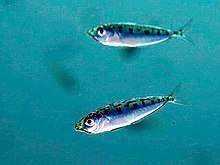Equulites elongatus
Equulites elongatus, the slender ponyfish, also called the elongate ponyfish, elongate slimy or elongated slipmouth, is a marine fish of the family Leiognathidae native to the western Pacific and Indian Oceans. As of 2011 it has been found in the eastern Mediterranean off Israel, where it is suspected to be an invasive species, a Lessepsian migrant, from the Red Sea via the Suez Canal.
| Equulites elongatus | |
|---|---|
 | |
| Scientific classification | |
| Kingdom: | Animalia |
| Phylum: | Chordata |
| Class: | Actinopterygii |
| Order: | Perciformes |
| Family: | Leiognathidae |
| Genus: | Equulites |
| Species: | E. elongatus |
| Binomial name | |
| Equulites elongatus (Günther, 1874) | |
| Synonyms[1] | |
| |

Description
Equulites elongatus has an elongated body compared to its congeners but has the downward pointing, protractile mouth typical of the family Leiognathidae situated underneath the pointed snout. The single dorsal fin has 8 spines and 16 soft rays. the first spine is small, the subsequent three spines are larger and they then decrease sharply in size towards the caudal fin while the dorsal rays are nearly equal in length. The anal fin has 3 spines and 14 soft rays, with the first spine being rather small and forked. The pectoral fin has 16 soft rays while the small pelvic fin a single spine and five soft rays with its origin is slightly in front of the origin of the pectoral fin. The head lacks any scales, while the cheek and breast are covered in small scales and there are spines on the nape. The upper body is dark grey in colour with irregular dark spots and the underside is silver-grey. The iris is silver-grey and the pupil is black. They grow up to 12 cm in length but the normal length is 8 cm.[2][3]
Distribution
Equulites elongates has an Indo-Pacific distribution which extends from the east coast of Africa through the coastal waters of south-western India eastwards to the Philippines, north to Japan and south to Australia.[2] It was recorded for the first time in the Mediterranean in 2011[4] and had reached Turkey by 2015, making it the second species of ponyfish to have colonised the eastern Mediterranean as part of the Lessepsian migration, the first being Equulites klunzingeri.[3]
Biology
Equulites elongates is a demersal species which is found in shallow waters to depths of 30m and is a gregarious species which is normally encountered inschools near the sea bed. It feeds mainly on benthic invertebrates such as small crustaceans and polychaete worms as well as algae.[2][4][5]
Fisheries
Equulites elongates is of minor commercial importance.[5]
Taxonomy
Analysis of mitochondrial DNA published in 2017 has suggested that Equulites elongates is in fact a species group made up of three species Equulites aethopos from the southern Red Sea; Equulites elongates from the south-east Asia and northern Australia; and Equulites popei from the Red Sea and eastern Africa east to the Andaman Sea.[6]
References
- "Synonyms of Equulites elongatus (Günther, 1874)". Fishbase. Retrieved 24 February 2017.
- Susan M. Luna; Estelita EmilyCapuki (2016). R. Froese; D. Pauly (eds.). "Equulites elongatus (Günther, 1874)". Fishbase. Retrieved 26 February 2017.
- Mehmet Baki Yokeş (2015). "First record of the Indo-Pacific slender ponyfish Equulites elongatus (Günther, 1874) (Perciformes: Leiognathidae) from Turkey" (PDF). BioInvasions Records. 4 (4): 305–308.
- Daniel Golani; Ronald Fricke; Brenda Appelbaum-Golani (2011). "First record of the Indo-Pacific slender ponyfish Equulites elongatus (Günther, 1874) (Perciformes: Leiognathidae) in the Mediterranean". Aquatic Invasions. 6 (1, supplement): s75–s77. doi:10.3391/ai.2011.6.S1.017.
- "Equulites elongatus". Encyclopedia of Life. Retrieved 26 February 2017.
- Hiromu Suzuki; Seishi Kimura (2017). "Taxonomic revision of the Equulites elongatus (Günther 1874) species group (Perciformes: Leiognathidae) with the description of a new species". Ichthyological Research. doi:10.1007/s10228-017-0572-9.